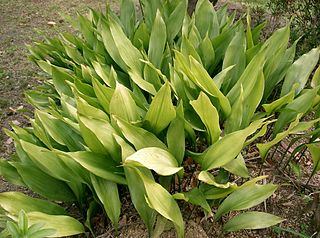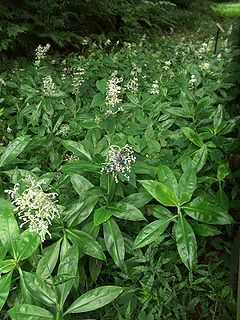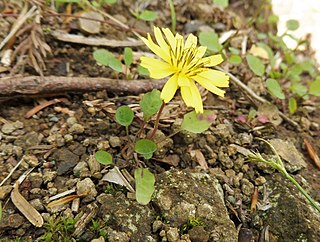
Aspidistra is a genus of flowering plants in the family Asparagaceae, subfamily Nolinoideae, native to eastern and southeastern Asia, particularly China and Vietnam. They grow in shade under trees and shrubs. Their leaves arise more or less directly from ground level, where their flowers also appear. The number of species known has increased considerably from the 1980s onwards, with around 100 accepted as of July 2013. Aspidistra elatior is common worldwide as a foliage house plant that is very tolerant of neglect. It and other species can also be grown in shade outside, where they are generally hardy to −5 °C (23 °F).

Carl Johann Maximovich was a Russian botanist. Maximovich spent most of his life studying the flora of the countries he had visited in the Far East, and naming many new species. He worked at the Saint Petersburg Botanical Gardens from 1852 as curator of the herbarium collection, becoming Director in 1869.

Fallopia is a genus of about 12 species of flowering plants in the buckwheat family, often included in a wider treatment of the related genus Polygonum in the past, and previously including Reynoutria. The genus is native to temperate and subtropical regions of the Northern Hemisphere, but species have been introduced elsewhere. The genus includes species forming vines and shrubs.

Aucuba is a genus of three to ten species of flowering plants, now placed in the family Garryaceae, although formerly classified in the Aucubaceae or Cornaceae.

Paris is a genus of flowering plants described by Linnaeus in 1753. It is widespread across Europe and Asia, with a center of diversity in China.

Allium monanthum, the Korean wild chive, is a spring vegetable with minuscule bulbous roots that have a mild onion flavor and found in the woodlands of Korea, Japan, northeastern Russia (Primorye), and northeastern China.

Rohdea is a genus of native to eastern Asia. It was long thought to contain only a single species, R. japonica, but recent studies have resulted in several other taxa being transferred into the genus.

Aletris, the colicroot, colicweed, crow corn, or unicorn root, is a genus of flowering plants in the Nartheciaceae family, native to North America and to eastern and southeastern Asia, especially China. It was used as a component in Lydia Pinkham's original Vegetable Compound.

Disporum is a genus of about 20 species of perennial flowering plants, found in Asia from northern India to Japan, south to Indonesia and north into the Russian Far East.

The genus Helwingia consists of shrubs native to eastern Asia, the Himalayas, and northern Indochina. It is the only genus in the family Helwingiaceae.

Syringa reticulata is a species of Lilac, native to eastern Asia: in northern Japan, northern China, Korea, and far southeastern Russia (Primorye).

Prunus campanulata is a species of cherry native to Japan, Taiwan, southern and eastern China, and Vietnam. It is a large shrub or small tree, growing 3–8 m (10–26 ft) tall. It is widely grown as an ornamental tree, and a symbol of Nago in the Ryukyu Islands of Japan. It is variously known in English as the Taiwan cherry, Formosan cherry, or bellflower cherry. It was described in 1883 by Carl Johann Maximowicz.

Ypsilandra is a genus of at least six herbaceous plant species, first described as a genus in 1888. This genus is a member of the Melanthiaceae and is native to East Asia.
Symphyllocarpus is a genus of flowering plants in the daisy family. The genus is poorly known, and botanists have not reached a consensus as to its evolutionary relations.

Pollia japonica, known as East Asian pollia in English, Yabumyoga(ヤブミョウガ) in Japanese, and dùruò(杜若) in Chinese, is a perennial flower native to East Asia. Its niche is forests 0–1200 m. It is native in Anhui, Fujian, Guangdong, Guangxi, Guizhou, Hubei, Hunan, Jiangxi, and Sichuan Provinces of China. Also found in Taiwan, Japan, and Korea.

Yoania is a genus of flowering plants from the orchid family, Orchidaceae.

Metaplexis is a genus of flowering plants in the family Apocynaceae, first described as a genus in 1810. As presently conceived, it contains two known species, both native to east Asia.

Mosla is a genus of plants in the family Lamiaceae, first described as a genus in 1875. It is native to eastern Asia, the Himalayas, and southeastern Asia.
- Mosla bracteataDoan ex Suddee & A.J.Paton - Vietnam
- Mosla cavalerieiH.Lév.- Vietnam, Guangdong, Guangxi, Guizhou, Hubei, Jiangxi, Sichuan, Yunnan, Zhejiang
- Mosla chinensisMaxim. - Vietnam, Korea, Japan, Anhui, Fujian, Guangdong, Guangxi, Guizhou, Hubei, Hunan, Jiangsu, Jiangxi, Shandong, Sichuan, Taiwan, Zhejiang
- Mosla coreanaH.Lév. - Korea
- Mosla dianthera(Buch.-Ham. ex Roxb.) Maxim. - China, Japan, Korea, Ryukyu Islands, Kuril Islands, Primorye, Caucasus, Himalayas, Myanmar, Vietnam, Philippines, Sumatra
- Mosla exfoliata(C.Y.Wu) C.Y.Wu & H.W.Li - Sichuan
- Mosla hangchouensisMatsuda - Zhejiang
- Mosla japonica(Benth. ex Oliv.) Maxim. - Japan, Korea, Ryukyu Islands
- Mosla longibracteata(C.Y.Wu & S.J.Hsuan) C.Y.Wu & H.W.Li - Guangxi, Zhejiang
- Mosla longispica(C.Y.Wu) C.Y.Wu & H.W.Li - Jiangxi
- Mosla pauciflora(C.Y.Wu) C.Y.Wu & H.W.Li - Guizhou, Hubei, Sichuan
- Mosla punctulataNakai - Korea, Taiwan, Japan, China
- Mosla scabra(Thunb.) C.Y.Wu & H.W.Li - Vietnam, Korea, Japan, Ryukyu Islands, Anhui, Fujian, Gansu, Guangdong, Guangxi, Henan, Hubei, Hunan, Jiangsu, Jiangxi, Liaoning, Shaanxi, Sichuan, Taiwan, Zhejiang
- Mosla soochouensisMatsuda - Anhui, Jiangsu, Jiangxi, Zhejiang
- Mosla tamdaoensisPhuong - Vietnam
Graphistemma is a species of plants in the Apocynaceae first described as a genus in 1876. It contains only one known species, Graphistemma pictum, native to Vietnam and S China.

Ixeris stolonifera, commonly called creeping lettuce, is a species of flowering plant in the aster family (Asteraceae). It is native to east Asia, where it is found in China, Japan, and Korea. It is a common and widespread species in Japan.


















